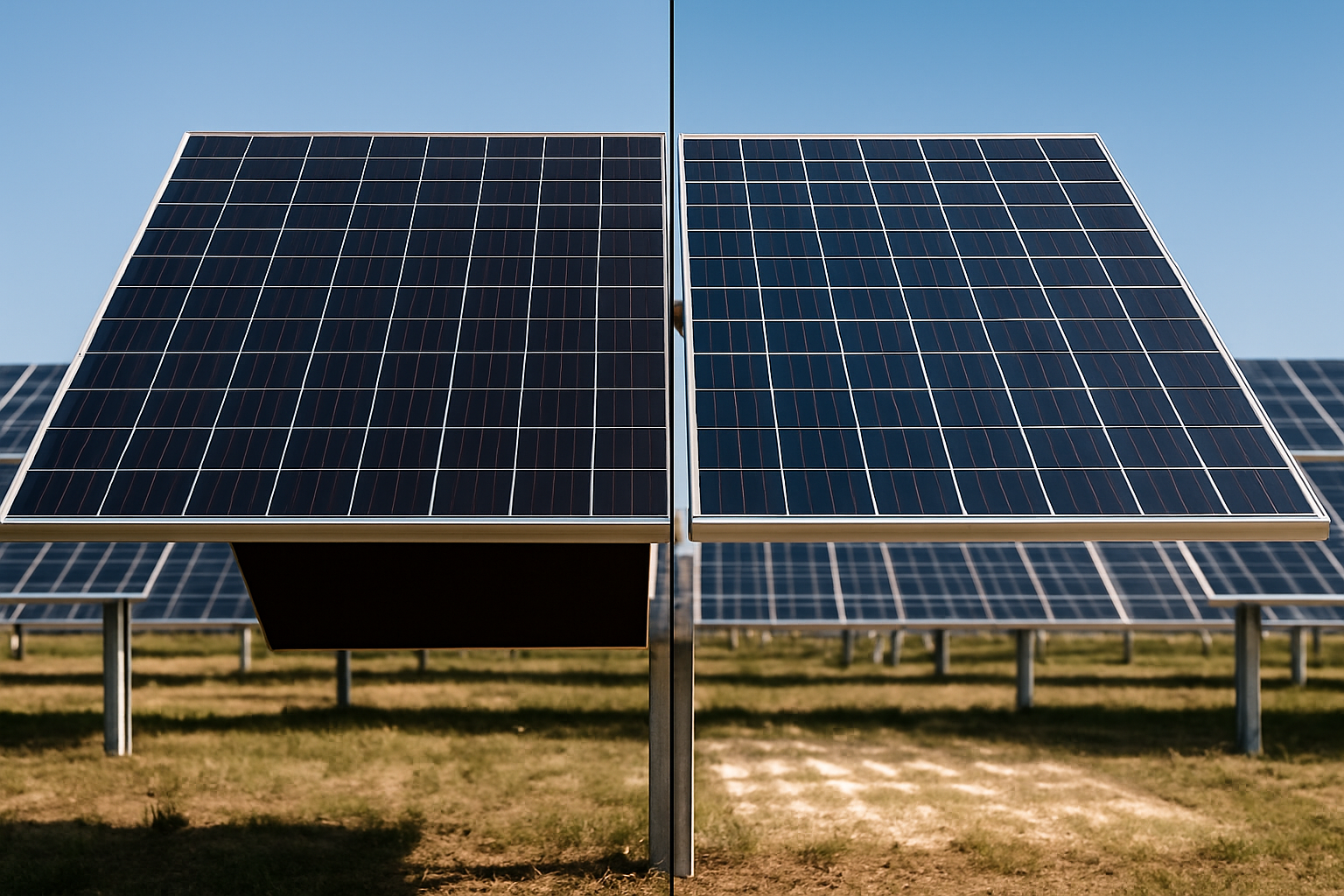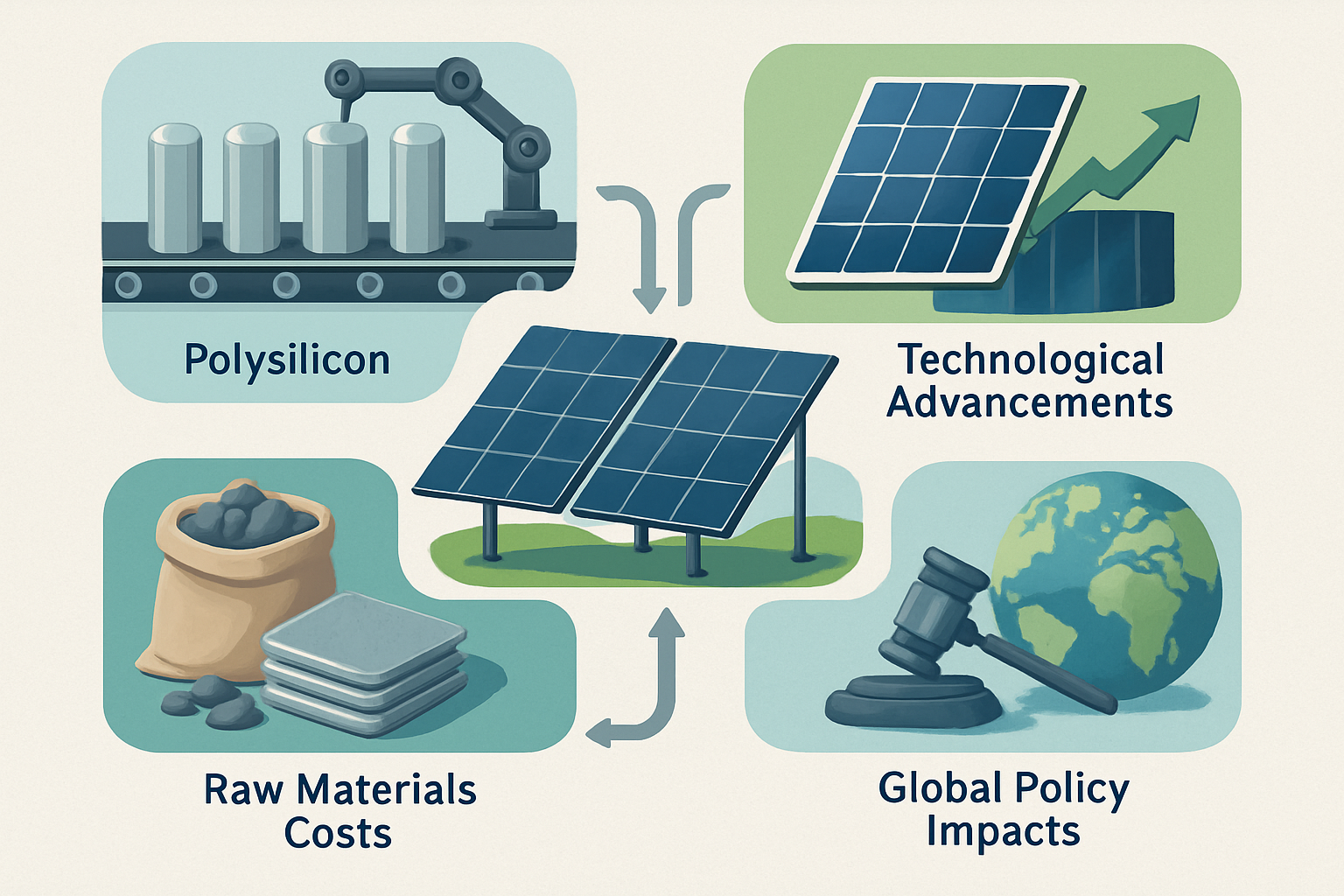The solar industry continually seeks innovative ways to boost energy production and system efficiency. Two key technologies, bifacial solar panels and solar trackers, promise significant gains. This discussion explores whether combining these technologies truly delivers a higher yield, offering a comprehensive look at their individual and combined benefits.
Understanding Bifacial Solar Panels
Bifacial solar panels represent a significant advancement in photovoltaic technology. Unlike traditional monofacial panels that capture sunlight from one side, bifacial panels are designed to collect light from both their front and rear surfaces. This dual-sided capability allows them to convert both direct sunlight and reflected light (albedo) into electricity.
How Bifacial Technology Works
Bifacial modules collect light on both sides, enabling major increases to energy yield. The front side captures direct sunlight, similar to conventional panels. The rear side, however, captures diffuse light reflected from the ground, snow, or surrounding surfaces. This reflected light, known as albedo, contributes to an additional energy gain, often referred to as 'bifacial gain.'
Factors Influencing Bifacial Gain
The amount of energy generated by the rear side depends on several factors. Ground cover reflectivity, or albedo, plays a crucial role; lighter surfaces like concrete or white gravel reflect more light, increasing the bifacial gain. Other system design factors, such as row spacing, the height of the modules above the ground, and the module layout, all affect the energy output of bifacial systems. Optimizing these parameters in tandem with module selection can further boost the output of bifacial systems. Bifacial technology is mainstream, but not dominant, in utility-scale PV (UPV) systems. Some bifacial gain is also available on flat-roof installations typical of commercial PV systems. However, you will not find bifacial gain on ordinary sloped-roof residential rooftop PV systems.
The Role of Solar Trackers in Energy Production
Solar trackers are mechanical devices that orient solar panels towards the sun throughout the day. This constant adjustment maximizes the amount of sunlight hitting the panels, thereby increasing energy production. Most U.S. UPV systems are now installed with single-axis trackers.
Types of Solar Trackers
Single-Axis Trackers: These trackers move the panels along a single axis, typically from east to west, following the sun's daily path. They are widely adopted due to their cost-effectiveness and significant yield improvements. Single-axis trackers can generate 12-25% more electricity than fixed systems in high insolation areas over a year.
Dual-Axis Trackers: These systems track the sun's movement both horizontally and vertically, adjusting for both daily and seasonal changes. Dual-axis tracking can increase the yield by an additional 10-15% compared to single-axis systems. While offering superior energy capture, the economic advantage can sometimes be offset by higher installation and maintenance costs for the supporting equipment.
Impact on Energy Yield
Trackers boost the amount of light reaching modules without much cost increase. Energy yield describes the annual energy produced by a PV system with a given DC nameplate rating. Operating efficiency depends on temperature and the details of incident light, which module design can influence. System design factors can also affect energy yield. The increased adoption of trackers and improved tracker performance can raise the energy yield of the nation’s PV fleet.
Synergistic Benefits: Bifacial Panels on Trackers
Combining bifacial panels with solar trackers creates a powerful synergy, enhancing overall energy yield beyond what either technology achieves alone. Trackers ensure the front side of the bifacial panel receives optimal direct sunlight, while the bifacial design simultaneously captures reflected light from the ground as the panel moves.
Maximizing Light Capture
When a bifacial panel is mounted on a tracker, the tracker's movement optimizes the angle for direct sunlight on the front. Simultaneously, this movement can expose the rear side to varying amounts of reflected light throughout the day. The constant adjustment helps in capturing diffuse light more effectively, especially in environments with high ground reflectivity. This combination allows for maximum light absorption from both direct and indirect sources.
Optimization for Enhanced Performance
To fully realize the benefits of bifacial panels on trackers, system design requires careful consideration. Row spacing, height above the ground, tracker design, module layout, and ground cover reflectivity all play a role in maximizing the energy output of bifacial systems. For example, increasing the height of the panels above the ground can allow more reflected light to reach the rear surface. Similarly, selecting a ground cover with high albedo, such as light-colored gravel or even snow, significantly boosts the bifacial gain. Optimizing these parameters ensures that the combined system operates at its peak potential, delivering a higher energy yield.
Practical Considerations and System Optimization
While the combination of bifacial panels and trackers offers compelling advantages, practical considerations are vital for successful implementation and long-term performance.
Cost-Benefit Analysis
The initial investment for bifacial panels and tracker systems can be higher than fixed, monofacial installations. However, the increased energy yield often translates to a lower levelized cost of electricity (LCOE) over the system's lifetime. For instance, dual-axis tracking can increase yield by an additional 10-15%, although in economic terms, this advantage can be offset by higher installation and maintenance costs for the supporting equipment. Evaluating the specific site conditions, energy demand, and economic incentives helps determine the optimal system configuration.
System Reliability and Maintenance
Reliability is paramount for any solar installation. Improving component reliability can reduce availability loss by eliminating faults and reducing the need for repairs. Inverters can trip off when they detect a ground fault or an arc fault. Decreasing the incidence of ground faults and arc faults further increases availability. Improving inverters and system design to eliminate false trips also reduces availability loss. Our expertise in developing robust lithium battery storage and integrated ESS solutions emphasizes the importance of reliable and scalable energy solutions, ensuring consistent performance and energy independence.
Reducing Mismatch Losses
PV modules can become mismatched due to different initial performance, varying degradation, or receiving different amounts of sunlight. This mismatch results in energy loss when interconnected modules are forced to operate at the same electrical condition. In residential PV, module-level power electronics (MLPE), including microinverters or DC power optimizers, resolve this problem by running each module at its optimal operating point. Mismatch loss may be reduced in larger systems using MLPE or by reducing mismatch in the first place.
Achieving Energy Independence
The solar industry has seen continuous advancements. The average efficiency of commercial silicon modules improved by about 0.3% per year, reaching 16% in 2013. The best-performing commercial modules offer efficiencies of 21%. Modules are usually guaranteed for a lifetime of 25 years at minimum 80% of their rated output, and sometimes for 30 years at 70%. By leveraging technologies like bifacial panels and solar trackers, you move closer to energy independence. Our company focuses on providing reliable and scalable energy solutions, including high-performance lithium iron phosphate (LiFePO4) batteries, integrated home energy storage systems, off-grid solar solutions, and solar inverters. These offerings support a future where you control your energy supply.
Frequently Asked Questions
What is bifacial gain?
Bifacial gain refers to the additional energy generated by the rear side of a bifacial solar panel from reflected light. This gain varies depending on factors like ground albedo, panel height, and row spacing.
How much more energy do solar trackers produce?
Single-axis trackers can increase energy yield by 12-25% compared to fixed systems. Dual-axis trackers can provide an additional 10-15% increase, though with potentially higher costs.
Are bifacial panels suitable for residential rooftops?
Bifacial panels typically do not offer significant bifacial gain on ordinary sloped-roof residential rooftop PV systems. They are more effective in ground-mounted utility-scale or commercial flat-roof installations where reflected light can be effectively captured.
What factors should I consider when installing bifacial panels on trackers?
Consider ground reflectivity (albedo), panel height, row spacing, and the specific tracker design. Optimizing these elements maximizes the combined system's energy output.
What is the typical lifespan of modern solar modules?
Modern solar modules are usually guaranteed for a lifetime of 25 years at a minimum of 80% of their rated output. Some guarantees extend to 30 years at 70% output.




Leave a comment
All comments are moderated before being published.
This site is protected by hCaptcha and the hCaptcha Privacy Policy and Terms of Service apply.